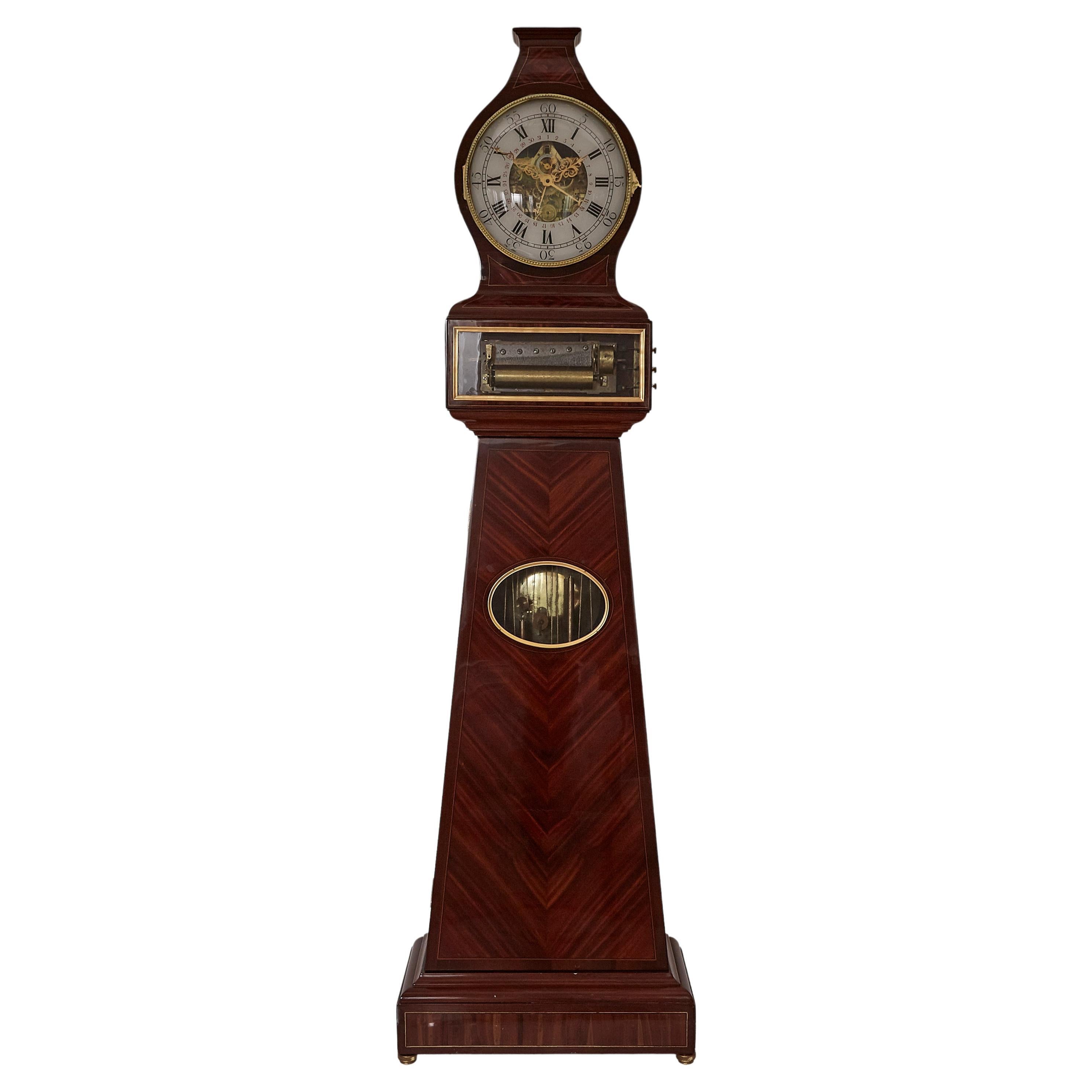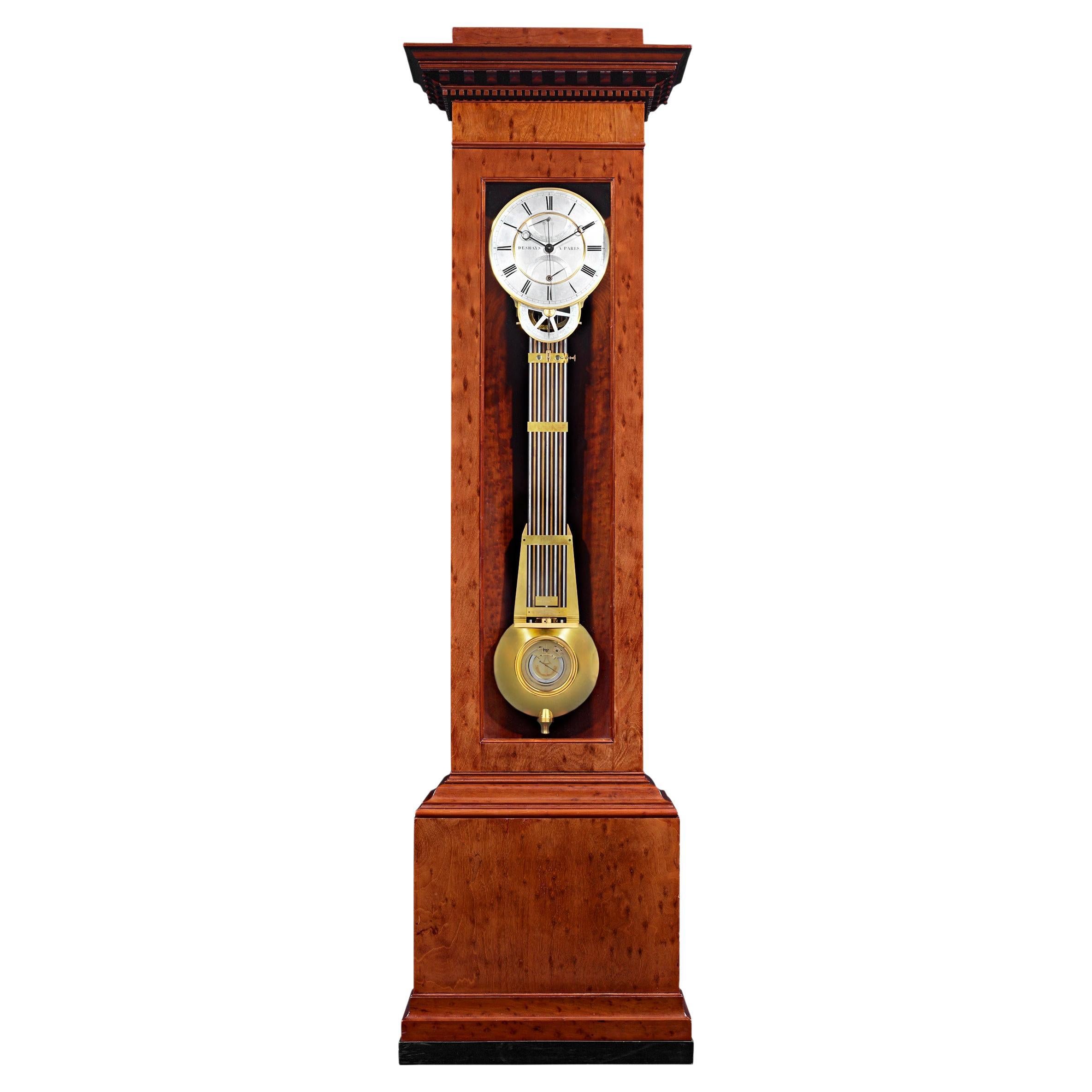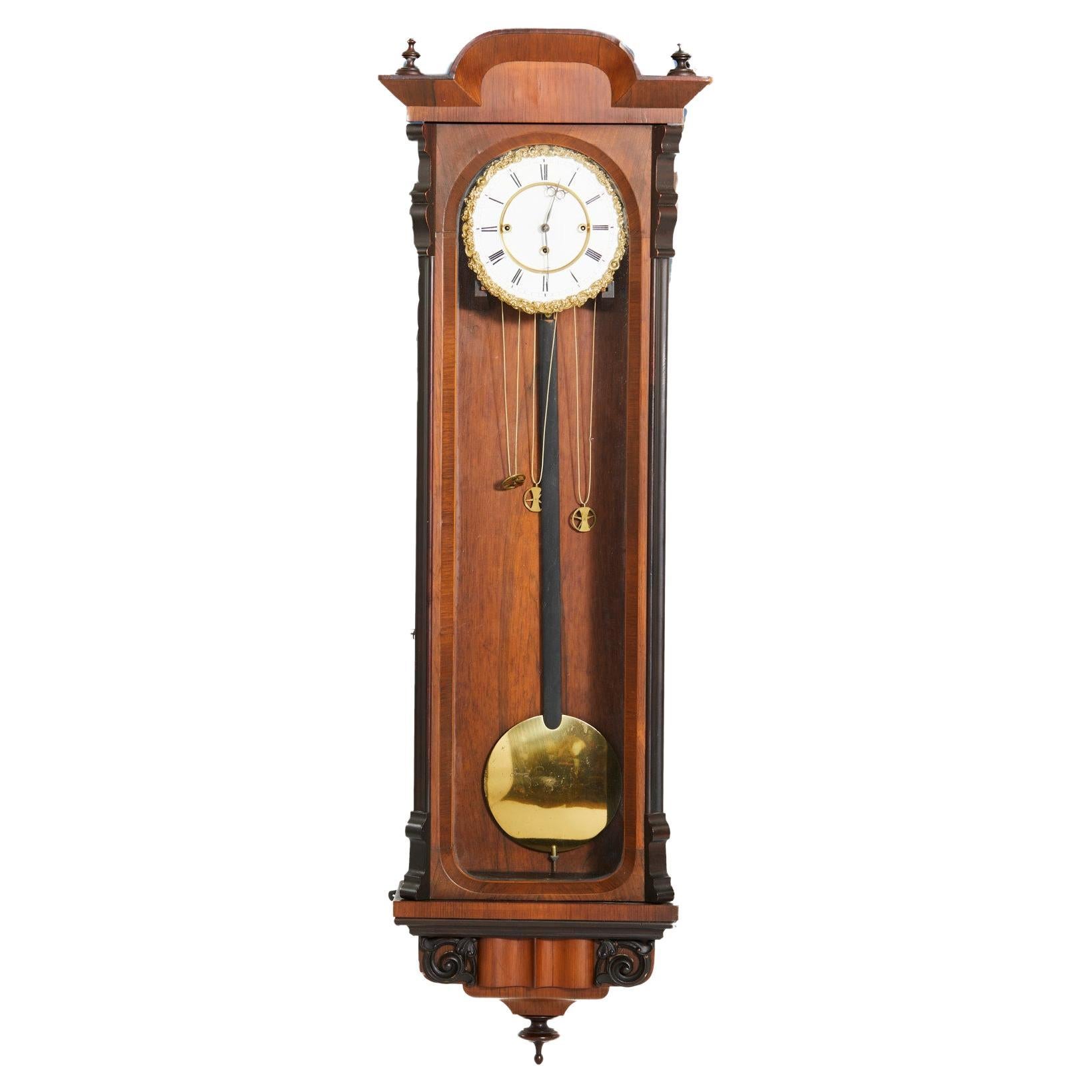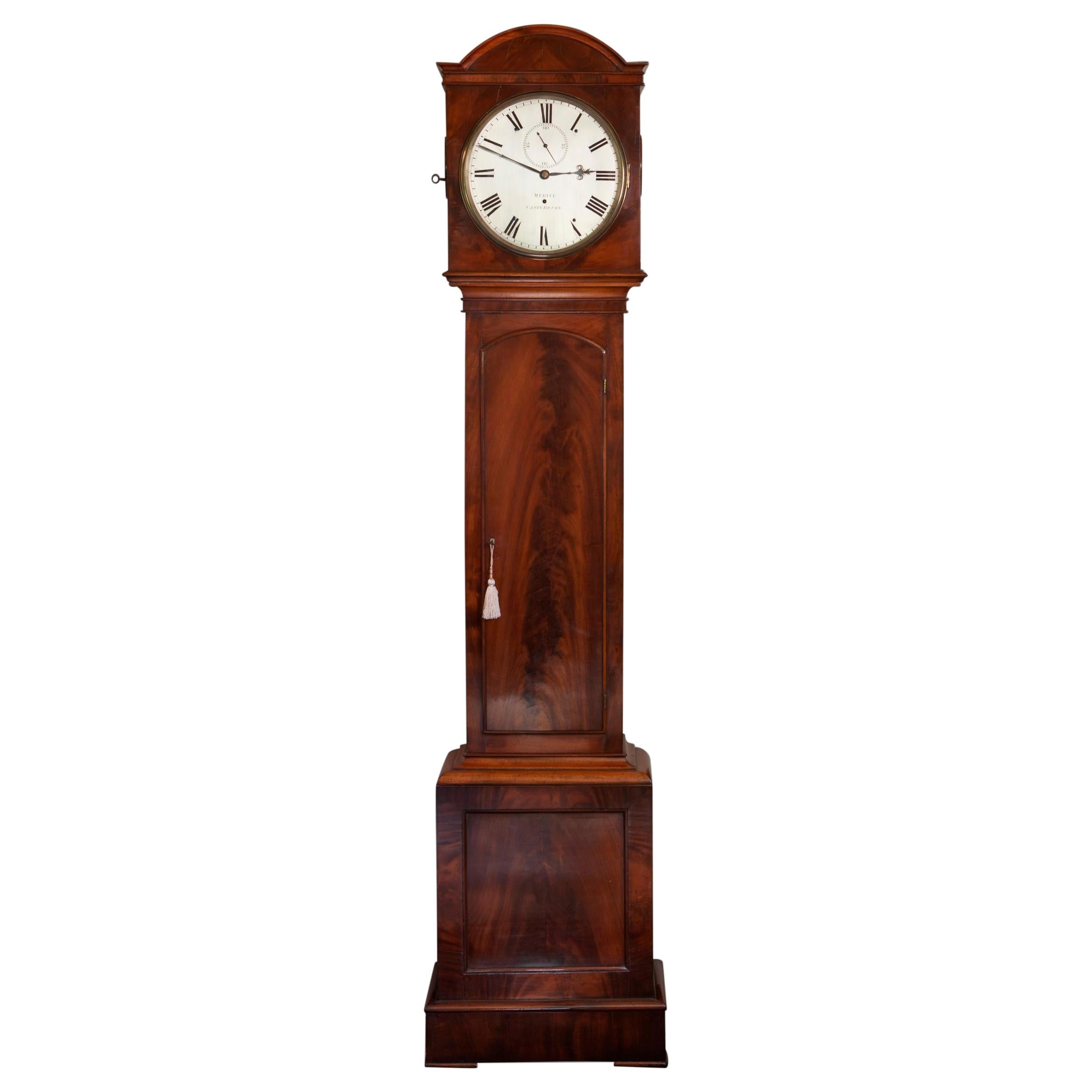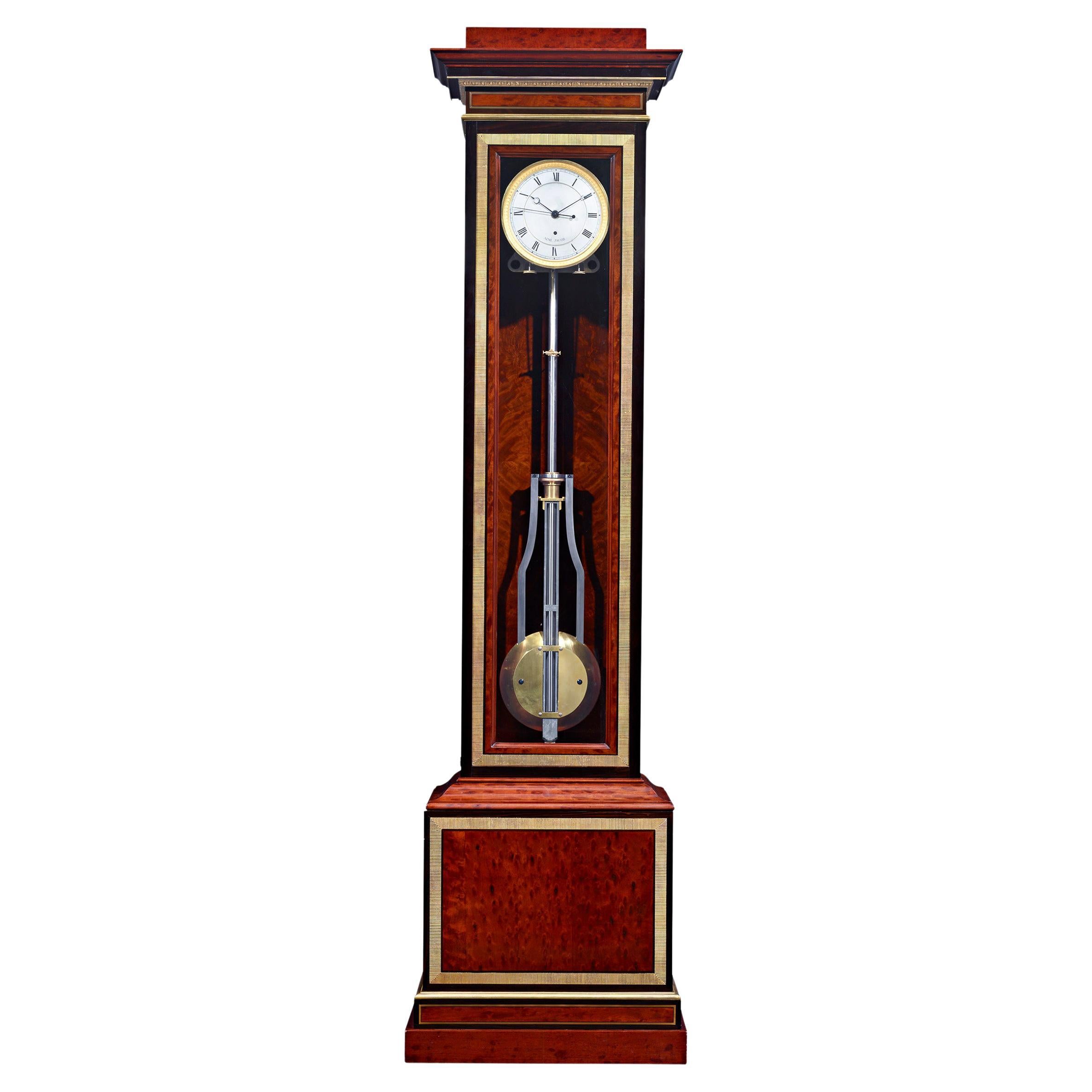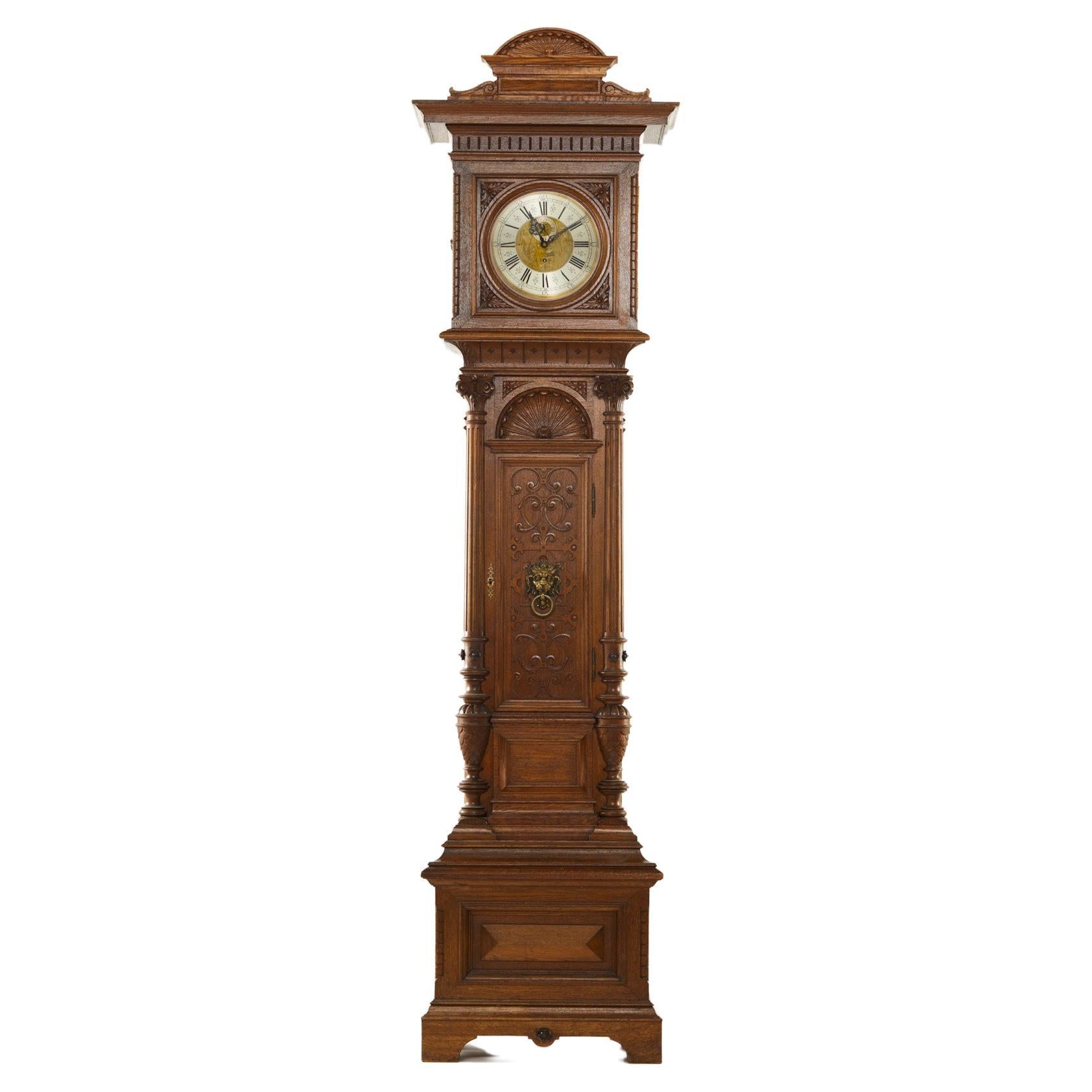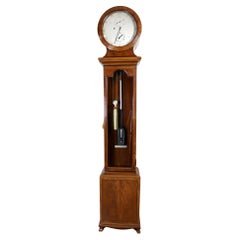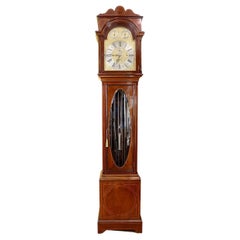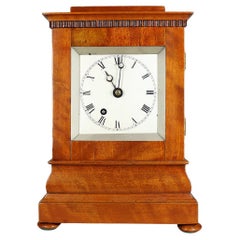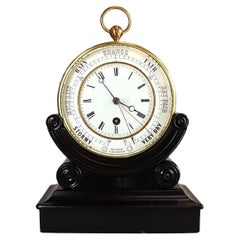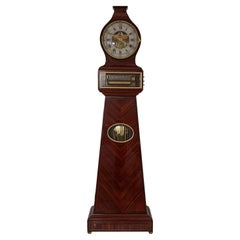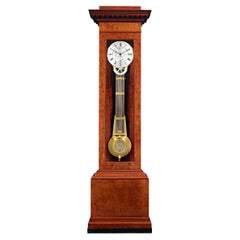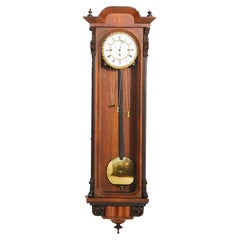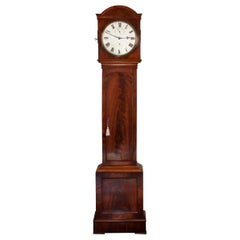Items Similar to Regulator by French Royal Exchange
Want more images or videos?
Request additional images or videos from the seller
1 of 7
Regulator by French Royal Exchange
$20,619.81
£15,000
€17,559.97
CA$28,798.65
A$31,232.82
CHF 16,404.66
MX$379,375.58
NOK 205,278.43
SEK 193,281.10
DKK 131,153.21
About the Item
A very fine regulator made by the firm of French Royal Exchange, the eight day movement with Harrison’s maintaining power and deadbeat escapement, is beautifully made with turned doric pillars and water of air patterned front and back plates. The pendulum has a wooden rod that has been gilded, to prevent expansion for precision timekeeping with a brass bound weight. The silvered observatory dial is crisply engraved with blued steel hands and numbered 972. The restrained mahogany case is in excellent condition with an arched top that has an access panel at the top.
In 1839 John Moore French, his sons John and William French established the firm known as 'The City Observatory' which was located at Cornhill in the City of London. They operated a Standard Time Ball controlled by a telegraph signal from Greenwich and specialized in the making of chronometers. They were in business at 9 Royal Exchange until 1875, examples of their work can be found in the Royal Collections.
The firm of French Royal Exchange were a renowned family of watch and chronometer makers who occasionally made long case clocks the were established in 1810, this clock dates from the 1850’s.
- Creator:French Royal Exchange London (Clockmaker)
- Dimensions:Height: 79.14 in (201 cm)Width: 22.05 in (56 cm)Depth: 13 in (33 cm)
- Style:Victorian (Of the Period)
- Materials and Techniques:
- Place of Origin:
- Period:
- Date of Manufacture:circa 1850
- Condition:Wear consistent with age and use.
- Seller Location:Amersham, GB
- Reference Number:Seller: 0391stDibs: LU9135236140672
About the Seller
No Reviews Yet
Vetted Professional Seller
Every seller passes strict standards for authenticity and reliability
1stDibs seller since 2023
5 sales on 1stDibs
Typical response time: 5 hours
- ShippingRetrieving quote...Shipping from: Amersham, United Kingdom
- Return Policy
Authenticity Guarantee
In the unlikely event there’s an issue with an item’s authenticity, contact us within 1 year for a full refund. DetailsMoney-Back Guarantee
If your item is not as described, is damaged in transit, or does not arrive, contact us within 7 days for a full refund. Details24-Hour Cancellation
You have a 24-hour grace period in which to reconsider your purchase, with no questions asked.Vetted Professional Sellers
Our world-class sellers must adhere to strict standards for service and quality, maintaining the integrity of our listings.Price-Match Guarantee
If you find that a seller listed the same item for a lower price elsewhere, we’ll match it.Trusted Global Delivery
Our best-in-class carrier network provides specialized shipping options worldwide, including custom delivery.More From This Seller
View AllArt Deco 1930's Regulator
Located in Amersham, GB
A very fine regulator dating from 1936 in a restrained art deco style. The large precision 8 day movement with Harrison’s maintaining power, and a dead beat escapement with six bar wheels...
Category
Vintage 1930s Scottish Art Deco Grandfather Clocks and Longcase Clocks
Materials
Brass, Steel
$24,056
Impressive Quarter Chiming Tubular Gong Longcase Clock
By Maple & Co.
Located in Amersham, GB
A very impressive quarter chiming tubular gong clock with a very high quality three train movement. The movement is of 8 day duration and strikes the quarter hours on eight chrome plated tubular gongs hanging from the rear of the case and the main hour on a coiled gong. Also featuring Westminster and Whittington chime...
Category
Antique 1890s English Edwardian Grandfather Clocks and Longcase Clocks
Materials
Brass, Steel, Chrome
A Very Fine Regency Library Clock
Located in Amersham, GB
This eight day single fusee library timepiece is of unusually small proportions, the a four pilars holding the two thick brass plates. The movement with anchor escapement has an adju...
Category
Antique 1830s English Regency Table Clocks and Desk Clocks
Materials
Brass, Steel
A Rare Bourdon and Richards Clock Barometer
Located in Amersham, GB
A very rare 19th century drum cased clock barometer, by Bourdon and Richards, Paris. This clocks innovative design has the barometer hand emerging from the centre of the clock hand a...
Category
Antique 1850s French Victorian Table Clocks and Desk Clocks
Materials
Brass, Enamel, Steel
John Leroux, London. Twin Fusee Balloon Clock
By John Leroux
Located in Amersham, GB
An 18th century balloon shaped bracket or table clock by John Leroux of Charing Cross, dating from circa 1790. The waisted case surmounted by a brass pineapple finial over a drum housing the movement. The dial is behind a hinged convex glazed cast brass bezel to front and brass carrying handles to sides, over hipped concave-sided section forming the base. The front has an applied mount of a sunburst mask, the rear with keyhole shaped door incorporating fine scroll-pierced sound fret set within the frame of the case, on generous cavetto moulded skirt base incorporating break-arch recess to apron and with ogee bracket feet.
The five knopped pillar twin fusee bell striking movement with rounded angles to the rectangular plates and anchor escapement regulated by a long bob pendulum with an effective length of approximately 11.5 inches, the backplate signed J. Leroux, London to centre, the 7 inch circular single sheet silvered brass Roman numeral dial signed Leroux, Charing Cross to centre, with fine pierced steel hands and Arabic five minutes to outer track.
An identical clock is illustrated in English Bracket and Mantel Clocks by Andrew Nicholls...
Category
Antique 18th Century English George III Mantel Clocks
Materials
Brass
Miniature Longcase Rocking Ship Clock by Sinclair Harding.
By Sinclair Harding
Located in Amersham, GB
Made by one of the last great english clock makers working in a traditional manner. This miniature longcase has an eight day weight driven movement with an automaton rocking ship in ...
Category
Vintage 1980s English George III Grandfather Clocks and Longcase Clocks
Materials
Gold Plate, Brass, Steel
You May Also Like
Standing Clock Regulator Styl England 18th Century
Located in Warsaw, PL
This imposing regulator clock is a testament to the precision and artistry of English horology during the 18th century. Designed for accuracy and often used in workshops, observatories, and other settings where precise timekeeping was paramount, the regulator represents a significant advancement in clockmaking technology.
The clock features a characteristic tall case, likely crafted from a fine hardwood such as mahogany or walnut. The case may be adorned with decorative elements such as marquetry or brass accents, adding to its visual appeal. The clock face, often made of enamel, likely displays Roman numerals and finely crafted hands, possibly with subsidiary dials for seconds or other functions.
The movement within the clock is likely of high quality, featuring intricate mechanisms designed for precision and reliability. The use of high-quality materials and meticulous craftsmanship ensures both functionality and aesthetic appeal.
This regulator clock stands as a testament to the ingenuity and craftsmanship of 18th-century English clockmakers. It would make a significant addition to any collection of fine horological instruments or serve as a captivating conversation piece in a study or library.
-There are functions such as seconds, minutes, hours, and only the month
- Music box with 8 tracks...
Category
Antique 18th Century French Other Grandfather Clocks and Longcase Clocks
Materials
Wood
$28,649 Sale Price
31% Off
Month-Going Regulator Clock by Deshays à Paris
Located in New Orleans, LA
This Louis-Philippe-period month-going longcase regulator clock is an exceptional example of French clockmaking, and its complicated mechanism marks several different aspects of passing time. Crafted by Deshays à Paris, the timepiece displays sleek silvered steel dials that indicate the time, date, month, equation of time...
Category
Antique 19th Century French Louis Philippe Grandfather Clocks and Longca...
Materials
Steel
19th Century Grande Sonnerie Vienna Regulator Clock
Located in Tarry Town, NY
Mid 19th century Mahogany wood / glass case grande Sonnerie three weight Vienna Regulator clock. The wall clock features a rosewood veneer with ...
Category
Antique 1830s European Wall Clocks
Materials
Brass
Mahogany Regulator Longcase Clock of Month Duration
Located in Norwich, GB
Regulator longcase clock of month duration
Early Victorian mahogany regulator standing on a raised, moulded plinth with centre panel to the b...
Category
Antique 19th Century British Victorian Grandfather Clocks and Longcase C...
Materials
Mahogany
Regulator Clock by Jean-Aimé Jacob and Adam Weisweiler
Located in New Orleans, LA
This important regulator clock beautifully demonstrates the heights of precision clockmaking. While regulator clocks are known for their incredible acc...
Category
Antique 19th Century French Louis XIV Grandfather Clocks and Longcase Cl...
Materials
Ebony, Mahogany
19th Century Johann Wien 90 Day Regulator Clock
Located in Tarry Town, NY
19th century hand carved oak case with carved capitals on full length waist columns and bracket feet, 90 day brass time only movement with deadbeat escapement and maintaining power t...
Category
Antique 1880s German Grandfather Clocks and Longcase Clocks
Materials
Brass
More Ways To Browse
Antique Brass Weights
Antique Regulator
Chronometer Watch
Antique Chronometer
1850 Antique Clocks
Regulator Clock
Regulator A
Antique Regulator Clocks
Chronometers
French Mahogany Clock
Antique Victorian Grandfather Clock
Antique Watch Makers
Victorian Mahogany Clocks
London Brass Clocks
Longcase Clocks London
French Antique Furniture London
French Regulator Clock
Longcase Regulator
